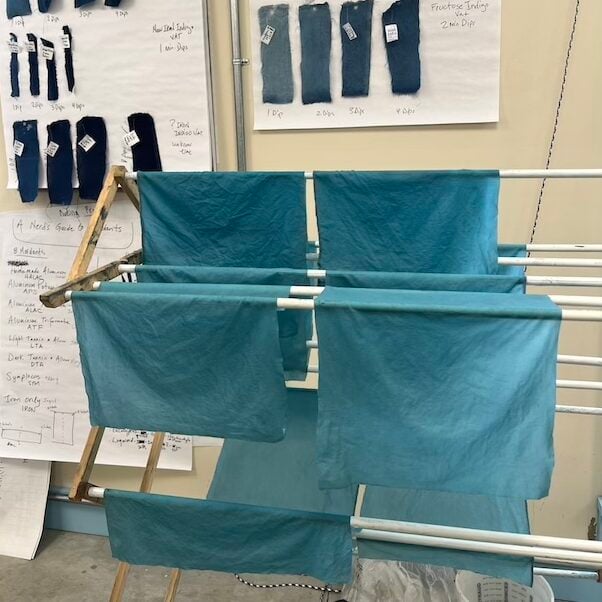We get mordant questions all the time at Botanical Colors so why not create Mordant Monday??? Got mordanting questions? Email [email protected]

2 light indigo dips on mordanted silk before immersing in exhaust dye baths to make pastels
YOU ASKED: My question involves the processes of indigo dyeing when combined with other plant dyes that have been mordanted with aluminum acetate. My understanding is that citric acid discharges the mordant and also neutralizes the alkalinity of indigo as a last step in finishing indigo dyed cloth. How would you go about neutralizing indigo without discharging mordant? For some processes, I am wanting to use indigo on top of other colors rather than underneath. Can vinegar be used without weakening the mordant bond?
KATHY ANSWERED: There’s a couple of questions that I’d like to comment on. The first is does the alkalinity of the indigo vat damage mordants? The answer is that it’s possible that many dips using a very strong vat for very long dips might cause a problem but the alum mordant bond is strong and seems to be able to withstand a few short dips in a vat. Normally when I am dipping mordanted fabric into indigo, I’m aiming for light shades so the other color can show through. What I mean by that is if I want to make a vivid leaf green using a premordanted bandana, I dip the bandana in indigo twice, usually for 30 seconds to a minute per dip. That gives me a medium blue that I can then overdye with yellow to get a nice green. If I am dipping a lot of dips (4-8) for 2 minutes at a time in a very strong vat, I am going to get a very dark blue. Attempting to overdye that color with a yellow will probably not show up well.
A related question is if the acid that I use to neutralize indigo after dipping matters. I think it does. The most commonly used acids for soaking fibers after indigo dipping are citric acid and vinegar (acetic acid) I don’t use citric acid to neutralize fibers after indigo dipping and prefer to use vinegar. My experience is that vinegar does not seem to impact the mordant or the color- at least it’s nothing I’ve noticed, and I only use a very small amount. It seems to remove excess calcium hydroxide and brighten colors well. Typically, we add about 1/4th cup (50-60ml) to a container of room temperature water and soak the indigo dyed goods for 20-30 minutes. After that, we finish rinsing and hang the dyed piece up to dry.
I’ve found that citric acid can strip color from mordanted fibers and as you mentioned, it can damage the mordant bond. One way that citric acid is very effective is that it can remove iron spots and stains. After a piece is treated with citric acid to remove iron, you may want to re-mordant if you are going to be using a mordant dye process.
So as you can see, I think it’s okay to use short dips in an indigo vat using mordanted fiber, and I don’t worry about damaging the mordant. I also prefer neutralizing indigo dyed fibers with vinegar instead of citric acid to avoid any color stripping actions from citric acid, and damage to iron mordanted fibers. And finally, citric acid is a good way to remove selective or unwanted iron from a fiber, but be aware you may need to remordant.
You might also like to read:
How to Dye With Indigo (to make 3 different types of vats)
Video: How to Make a Fructose Indigo Vat
Video From LIVE FEEDBACK FRIDAY: Rowland Ricketts
Shop:
